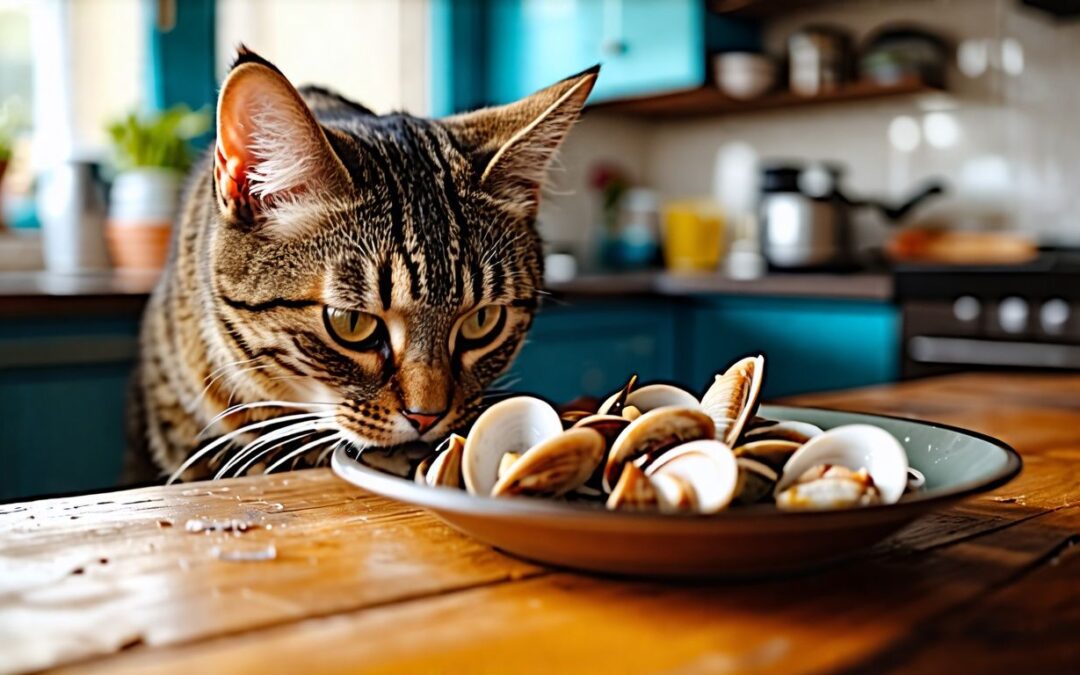Many cat owners wonder if it’s safe for their furry friends to eat clams. Clams are rich in taurine, which is vital for cats’ health. This article will explore the benefits and precautions of feeding clams to your cat. Keep reading to learn more!
Key Takeaways
- Cats can safely eat clams when they are cooked properly to avoid harmful bacteria. Clams offer important nutrients like taurine, protein, omega-3 fatty acids, iron, and vitamin B12 which support a cat’s health.
- Always introduce clams into your cat’s diet gradually to check for any allergic reactions or digestive sensitivities. It’s also essential to remove shells to prevent choking or injury.
- Feeding cats clams in moderation is crucial because overfeeding can lead to digestive issues and an imbalance in their diet. Clams should be a treat rather than a staple of their daily meals.
- Some cats may have allergic reactions or show signs of discomfort after eating clams. Monitoring your pet closely when introducing new foods like clams will help identify any adverse effects early on.
- For those looking for safer alternatives to clams, freeze-dried mussels are recommended. They provide similar nutritional benefits without the risk of bacterial contamination and shell hazards that come with raw seafood.
Briefly touch on the topic of cats eating clams
Cats can eat clams, and these shellfish offer notable nutritional benefits for feline diets. Clams are rich in taurine, an essential nutrient cats require for heart health and vision.
Including clams in a cat’s meal plan introduces high-quality protein, omega fatty acids important for skin and coat health, as well as minerals like iron and vitamin B12. Taurine deficiency can lead to serious health issues in cats, making the inclusion of taurine-rich foods like clams valuable.
Feeding cats clams should be approached with caution due to potential risks such as allergic reactions or digestive sensitivity. Contamination is another concern; raw seafood may harbor bacteria leading to food poisoning unless properly cooked before being added to a cat’s dish.
Moderation is crucial—overfeeding clams can result in negative consequences due to their high mineral content.
Mention the potential benefits and risks
Clams can provide essential nutrients for cats, including taurine, which is vital for their health. They are a good source of protein, omega-3 fatty acids, iron, and vitamin B12. These nutrients can support a cat’s overall well-being and help prevent health issues associated with taurine deficiency.
However, there are risks to consider before adding clams to a feline diet. Some cats may have allergic reactions or digestive sensitivity to shellfish. Contamination from bacteria in raw seafood poses a risk of food poisoning in cats as well.
Shell hazards also exist if clams are not properly prepared; sharp edges can harm your pet’s mouth or digestive tract.
Nutritional Value of Clams for Cats
Clams offer valuable nutrition for cats, including high protein and essential omega-3 fatty acids, which support their overall health. The presence of iron and Vitamin B12 can also benefit your feline friend’s energy levels.
For more on this topic, continue reading!
Protein content
Clams offer a significant amount of protein, making them a beneficial addition to a cat’s diet. This protein is essential for muscle development and overall health in felines. Including clams can help meet the dietary protein requirements that cats need to thrive.
The presence of taurine in clams also supports heart health and vision, contributing to the well-being of your pet.
Feline nutrition relies heavily on high-quality protein sources. Clams contain approximately 12 grams of protein per 100 grams, providing an excellent option among seafood choices.
A balanced diet incorporating clams ensures that cats receive vital nutrients while enjoying different flavors as part of their meals.
Omega-3 fatty acids
Clams provide omega-3 fatty acids, which are beneficial for cats. These essential fats support heart health and help maintain a shiny coat. They also contribute to reducing inflammation in the body.
Omega-3s play a vital role in promoting overall well-being in felines.
Including clams in moderation can enhance your cat’s diet with these important nutrients. It’s essential to ensure that any seafood, including clams or shellfish like mussels, is cooked properly to avoid harmful bacteria that could lead to food poisoning.
Iron and Vitamin B12
Clams provide essential nutrients like iron and Vitamin B12. Iron is vital for producing red blood cells, supporting oxygen transport in your cat’s body. Insufficient iron can lead to anemia, which may make a cat lethargic and weak.
Vitamin B12 plays a crucial role in nerve function and the production of DNA. A lack of this vitamin can cause neurological issues over time.
Including clams in your feline’s diet offers these benefits while also providing taurine, an essential nutrient for cats. Always ensure that any seafood you offer is cooked thoroughly to reduce the risk of bacterial infections associated with raw products.
Risks and Precautions
Cats can have allergic reactions to clams, so it’s crucial to watch for any signs of discomfort. Digestion issues may also arise, especially if the shellfish is not prepared properly or comes from contaminated waters.
Possible allergic reactions
Some cats may experience allergic reactions to clams. These reactions can manifest as skin irritations, vomiting, or diarrhea. Signs of an allergy might appear shortly after consuming shellfish.
Close monitoring is essential if you introduce clams into your cat’s diet.
Clams contain various nutrients, but caution is necessary. If a cat has never eaten shellfish before, introducing it carefully helps identify any potential sensitivities. Consulting with a veterinarian before adding clams ensures pet food safety and supports feline nutrition in a manner that prioritizes the health of your cat.
Digestive sensitivity
Digestive sensitivity in cats can vary widely. Some cats may struggle to digest shellfish like clams. This can lead to upset stomachs or other gastrointestinal issues. Raw seafood often contains bacteria that could worsen digestive problems, potentially causing food poisoning.
Cooking clams kills harmful bacteria and makes the nutrients more accessible.
Not every cat has the same tolerance for new foods. Introducing clams into a cat’s diet should start slowly to monitor for any adverse reactions. Clams are nutritious; they provide taurine, which is essential for overall health.
However, due caution is necessary when adding them as a treat alongside fish or other seafood options such as shrimp or mussels.
Contamination and shell hazards
Clams can pose contamination risks that may affect your cat’s health. Raw fish and seafood, including clams, sometimes carry bacteria that can lead to food poisoning in cats. Cooking the clams thoroughly eliminates this risk and makes them safer for feline consumption.
Shells also present hazards; sharp edges can cause choking or injury to a cat’s mouth or digestive tract. Always ensure you remove any shells before offering clams to your pet. Keeping safety in mind allows you to introduce this nutritious option into their diet without unnecessary risks associated with shellfish.
Moderation is Key
Cats should enjoy clams in moderation to stay healthy. Too many can lead to digestive issues or other health problems.
Importance of not overfeeding clams to cats
Overfeeding clams can lead to digestive issues in cats. Introducing this seafood in moderation is crucial, as excessive consumption may upset their stomach and cause discomfort. While clams offer benefits, such as being a good source of taurine, too many can overwhelm your cat’s system.
A lack of balance in a cat’s diet can result in health problems over time. Always remember that foods like shrimp or fish should also be part of their varied diet to ensure they receive all necessary nutrients without relying solely on one type of shellfish.
Potential consequences of excessive clam consumption
Excessive clam consumption can lead to health issues in cats. A lack of balance in their diet may result from overindulging in clams, which provide high levels of protein and zinc.
While clams are nutritious and a good source of taurine, moderation is essential. Consuming too many can upset a cat’s digestive system, leading to potential discomfort or illness.
Clams also pose risks due to contamination or shell hazards. Raw seafood carries bacteria that can cause food poisoning in cats. Overfeeding clams increases the chances of exposure to such risks.
Always introduce new foods like shellfish gradually and keep an eye on your cat’s response for any adverse reactions when enhancing their diet with seafood options like mussels or other safe alternatives.
Alternative Seafood Options for Cats
Some seafood choices offer a great alternative to clams for your cat. Freeze-dried mussels are easy to prepare and packed with nutrients that can support your pet’s health.
Green lipid mussels
Green lipid mussels offer a nutritious seafood option for cats. They are rich in important nutrients like taurine, which is essential for a cat’s health. These mussels can provide protein and omega-3 fatty acids while also being easier to digest than some other shellfish.
Unlike clams or raw fish, green lipid mussels have a lower risk of contamination when prepared properly. Freeze-dried versions make them even more convenient and safe as an occasional treat.
Cats can enjoy the benefits of seafood without the potential hazards associated with consuming clam shells or raw products that may harbor harmful bacteria.
Freeze-dried mussels as a safer alternative
Freeze-dried mussels serve as a safer alternative to clams for cat diets. These mussels maintain essential nutrients while reducing the risk of contamination and shell hazards. They provide a good source of taurine, which is vital for cats’ overall health and well-being.
Unlike raw seafood, freeze-dried options eliminate concerns about harmful bacteria that can lead to food poisoning in cats. Feeding freeze-dried mussels in moderation allows you to introduce seafood into your cat’s diet without the associated risks of other shellfish like clams.
Offering these tasty treats can enrich your pet’s nutritional intake while keeping them safe. Other seafood options are also available for those looking to enhance their cat’s diet even further.
Benefits and recommended feeding guidelines for freeze-dried mussels
Freeze-dried mussels offer a nutritious option for cats, providing a good source of taurine. This nutrient is essential for their overall health and well-being. Freeze-drying helps retain the nutrients without exposing the mussels to harmful bacteria found in raw seafood.
Introduce freeze-dried mussels gradually to your cat’s diet to monitor any potential allergic reactions or digestive sensitivity. A small amount is sufficient as a treat or supplement, ensuring that clams and other shellfish are not overfed.
Consider these guidelines before incorporating new seafood options into your pet’s meals.
Conclusion
Clams can be a tasty and nutritious treat for your cat when served correctly. They provide essential nutrients like taurine, which supports their overall health. Always cook clams thoroughly to prevent any health risks, and introduce them gradually into your cat’s diet.
Moderation is key to ensuring that your feline friend enjoys the benefits without any negative effects. With proper care, clams can be a delightful addition to your kitty’s meals!
FAQs
1. Can cats eat clams and other seafood?
Yes, cats can eat clams as well as other types of seafood like fish, shrimp, lobster, crab, scallops and squid.
2. Is it safe for cats to consume shellfish such as mussels and oysters?
While some cats may enjoy shellfish like mussels or oysters, it’s crucial to serve these in moderation due to their high sodium content.
3. Are there any risks if my cat eats too much seafood?
Eating too much seafood can lead to health issues in cats such as allergies or digestive problems.
4. What should I consider before feeding my cat with clams or other sea creatures?
Before feeding your cat with clams or any other sea creature make sure they are fresh and properly cooked to avoid potential health hazards.






